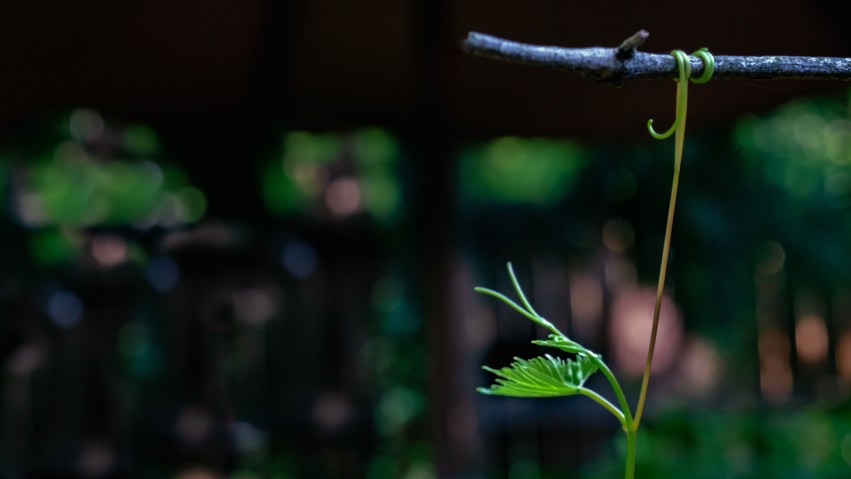From Garden Flora: The Natural and Cultural History of the Plants In Your Garden by Noel Kingsbury:
“Vitis (from the Greek for the plant) includes approximately 60 species. The distribution is almost entirely temperate northern hemisphere with some penetration into South America…. Nearly all Vitis species are lianas, are wind-pollinated, and have roots that can store considerable quantities of nutrients during the dormant season. They form an integral part of forests, climbing up trees to produce their leaves, flowers, and fruit often tens of metres above ground level. They are particularly lush in woodland edge habitats, where their ability to cover trees may result in them being visually dominant….
“The appreciation of the grape vine simply as an ornamental plant is a recent interest — a few centuries, compared to the thousands of years the plant has been cultivated for its fruit and its fermented juice.”
From The Secret Life of Plants by Peter Tompkins and Christopher Bird:
“A climbing plant which needs a prop will creep toward the nearest support. Should this be shifted, the vine, within a few hours, will change its course into the new direction. Can the plant see the pole? Does it sense it in some unfathomed way? If a plant is growing between obstructions and cannot see a potential support it will unerringly grow toward a hidden support, avoiding the area where none exists.”
“When the tendril, which sweeps a full circle in sixty-seven minutes, finds a perch, within twenty seconds it starts to curve around the object, and within the hour has wound itself so firmly it is hard to tear away. The tendril then curls itself like a corkscrew and in so doing raises the vine to itself….
“Plants … are capable of intent: they can stretch toward, or seek out, what they want in ways as mysterious as the most fantastic creations of romance.”
This is the first of four posts featuring two grapevines growing in my garden. Even though I’ve posted pictures of these vines before (see Secrets Inside a Grapevine), I look forward to pushing my face and my macro lens into these two vines every spring and summer. Aside from the fact that they started as a gardening experiment (I didn’t know if they’d live because my back yard is heavily shaded), they ended out being among the longest living perennials I’ve planted (one now returning for seven seasons and the other one returning for eleven), I’m always fascinated by the shapes and forms they assume each spring. I’ve taken dozens of closeup photos of each one, attempting to approach them a little differently every time, trying out a variety of camera settings and using them as a subject to learn more about exposure, focal length, lighting and color.
There’s a wildness to their growth that at least partly accounts for my obsession with photographing them, and their largely unrestrained spread lets me create bits of drama with each image. Both vines continue to produce tiny new leaves throughout most of the summer, along with masses of tendrils that, occasionally, I snip from nearby bushes, plants, and even chairs to encourage them to take different paths. Both vines grow rapidly; like my wisteria and ivy ground cover, I keep an eye out for intrusiveness that can get out of control in a matter of days. Once their leaves drop off in late fall, I’ll trim each one back so that the woody stems are even with each plant’s supports, and it’s always entertaining (to me!) to see what tricks they have in store for the following spring.
This first vine — the younger of the two — is a Catawba Grapevine. It’s notable for the magenta colors on the back side of each new leaf, and many of the tendrils will start out as bright orange or red (as in the second photo) before they lengthen, start searching for targets, and gradually fade to light green as the leaves get larger and turn dark green (like the top leaf in the third photo).



The older vine, below, is a Concord Grapevine. It produces intricately structured leaves in a range of green and yellow-green colors, along with a large number of tendrils that (even confined by the pot and garden space it’s in) will reach nearly a foot in length before they latch onto something nearby.
The Concord’s more of a free-wheeler than the Catawba; its stems will stretch and hang suspended in the air much longer before the tendrils make attachments, which (from The Photographer’s point of view) can provide for some neat contrasts in colors, shapes, and lines.



This last photo is also from the Concord; it’s like a grapevine’s aspirational meme that I discovered one evening just before dark.
Imagine, for a moment, what this tiny leaf and tendril had to “know” about its surroundings to reach up, hook itself to that stick, and wrap around the stick to raise itself from the rest of the plant. Have a little fun and write your own caption! 🙂

Thanks for reading and taking a look!





























































